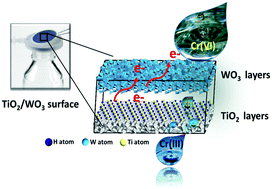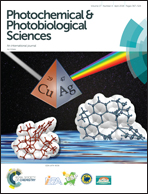Sunlight-charged heterojunction TiO2 and WO3 particle-embedded inorganic membranes for night-time environmental applications
Abstract
A metal oxide-heterojunction photocatalyst is developed to harvest sunlight, store the energy in electrons, and apply the stored energy in water treatment. Light-absorbing nanoparticular and nanotubular TiO2 are hybridized with electron-storing WO3 at different weight ratios of TiO2 to WO3 (e.g., TW25 represents a composite of 25 wt% TiO2 and 75 wt% WO3). The ability of the TW composite to utilize the stored electrons is examined for the reduction of hexavalent chromium (Cr(VI)). In the photoelectrochemical (PEC) tests, irradiation using simulated sunlight (AM 1.5, 100 mW cm−2) leads to a rapid shift in the open-circuit potential (OCP) of the TW electrodes to the negative potential region (photocharging process). The termination of irradiation causes a gradual shift of the OCP to the positive potential region over 20 h (discharging process). Spiked Cr(VI) added to the solution with pre-photocharged TW electrodes is efficiently removed; the kinetics of this process depends on the TW composition (25, 50, or 75 wt%), TiO2 morphology (particular or tubular), initial Cr(VI) concentration (0.125 or 0.25 ppm), and whether the conditions are aerated or non-aerated. Based on this knowledge, TW composite-embedded inorganic membranes are synthesized and charged using sunlight. For Cr(VI) removal, single-pass and continuous circulation filtration systems are employed. The fraction of Cr(VI) removed from the circulation system is ∼30% in 4 h, which is 1.5 times that removed using the single-pass filtration system (∼20%). An X-ray photoelectron spectroscopy analysis of the TW membranes used for Cr(VI) removal reveals that Cr is not sorbed in the membrane. The W(VI) in WO3 is partially reduced to W(6−x)+ upon photocharging and is oxidized during the reduction of Cr(VI), leading to the co-existence of W6+ and W(6−x)+.

- This article is part of the themed collection: 28th International Conference on Photochemistry (ICP 2017)


 Please wait while we load your content...
Please wait while we load your content...